E-News Spring 2015
Founded in July 1987 Tile Heritage celebrates its 27th anniversary this year. Supporters like YOU... members, major contributors, industry sponsors, generous grantors... everyone... have made possible the continued fulfillment of the Foundation’s mission to Document and Preserve tile history in the U.S., both past and present. THANK YOU!
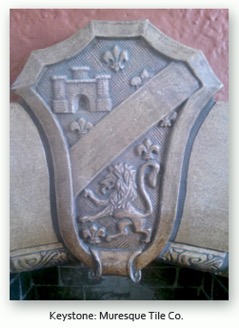
(Our apologies for the quick links to each story being currently out of commission. Click on the ‘Read More’ link (below) to view all of the Spring 2015 E-News postings.)
Muresque in Denver
...and in Oakland
Rhead Frieze Finds New Home
More Hamilton Tiles
A Tile Painting Experience
New Books
Please Participate!
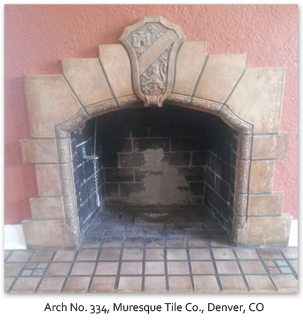
Muresque in Denver?
Thanks to research done in 1995 by Tom Turnquist, we know that the Muresque Tile Company was established in Denver, Colorado in 1936 by David Heany, who had purchased the molds and equipment from William Muir in Oakland, California the previous year. Heany set up shop at 224 W. 10th Ave. A year later the company was purchased by F. J. Goldsmith, who published a product catalog and moved the operation to 3220 Mariposa St. where it remained a going concern until 1941. In addition to this house on Niagara Street, another on N. Kearney and a third on Jasmine St., no other Muresque installations are known at this time.
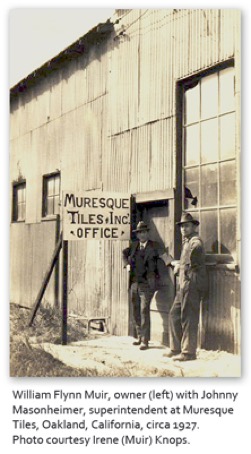
The original Oakland-based company, Muresque Tiles, Inc., was founded in 1925 by William Flynn Muir and his wife Vesta. Muir was born and reared in Scotland and as a young man apprenticed as a tile setter in Glasgow. He immigrated through Canada to the U.S. arriving in Fresno, California in 1913.
Muir was well prepared for the trade and, with a partner, started his own tile contracting business, becoming increasingly familiar with the handcrafted tiles being produced in the state at that time.
In 1925, with his wife, father-in-law, two young children and his entrepreneurial spirit in full flower, Muir moved to Oakland to manufacture a line of high-relief tiles called ‘Muresque.’ Clearly inspired by the earlier work of Batchelder and Claycraft Potteries, Muir had his tiles hand-pressed from plaster molds; pigmented mineral slips (engobes) were applied to provide the subtle coloration.
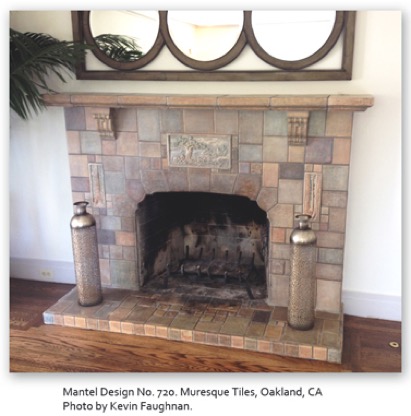
The decorative tiles were designed to be symmetrically placed around a fireplace facade, the focal point in the home. Subject matter frequently combined romantic medieval imagery (castles, knights on horseback, etc.) with picturesque California landscape. Sailing ships were often dramatized in turbulent seas, clearly a celebration of the adventurous spirit of the early European mariners.
Muresque Tiles fell victim to the Depression, but not before the publication in1930 of a fully illustrated catalog of its decorative work, available at tileheritage.org.
Joseph Taylor
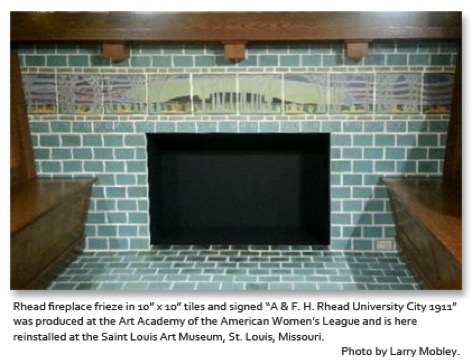
Frederick Hurten Rhead Finds New Home in St. Louis
From Larry Mobley, Mobley & Co.
In 2002 I was contacted by the Saint Louis Art Museum to remove a Frederick Hurten Rhead tile frieze from a fireplace at the John J. Meachem House in University City, Missouri that was built in 1911. To complement vases that were made by Rhead, the museum wanted to add the fireplace tiles to its collection.
At the residence a dust containment room was built around the fireplace because the house was still occupied. I had to wait until the lead paint was removed from the surrounding walls. The museum staff removed the mantel, benches, and some of the hardwood flooring. The tiles were then numbered and removed by me. The tiles were sent to the museum where I removed cement and grout. It took me one and a half weeks to do this job. The museum stored the tiles until they were ready to be re-installed.
In September of 2014, returning from a job in New Mexico, I stopped at the museum to seethe fireplace. I learned that it had been installed a year before. The museum staff and a custom carpenter installed a cozy setting, an inglenook, on the third floor accompanied by the Rhead vase collection.
The museum had done a wonderful job in preserving these beautiful tiles for all to enjoy.
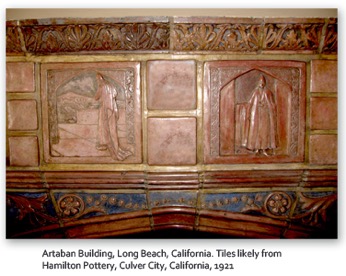
More Hamilton Tiles
Recently tile sleuth, Brian Kaiser, in arranging for a tile tour of Long Beach, California, discovered a remarkable fireplace mantel at the Artaban Apartments, 10 Atlantic Avenue. Two decorative tiles above the firebox appear to depict Artaban himself, the other ‘wise man’ in Christian theology, who sought unsuccessfully throughout his life to commune with Jesus Christ.
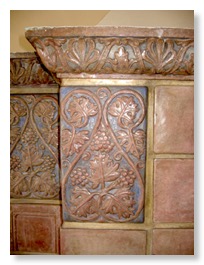
For confirmation that the installation was produced at Hamilton Pottery in Culver City, we emailed Steve Soukup, who ‘discovered’ the tile-making pottery some years ago and who first wrote about it in “E-News for Winter 2012.”
After a little sleuthing on his part, he wrote: “I noticed that the Artaban is located within blocks of the Sovereign Hotel where we know the lobby fireplace is Hamilton and not Batchelder as presumed by most. The Sovereign was built in 1922-23 and the Artaban in 1921 according to Long Beach city records. It would not be unusual for tiles from the same maker to be found in nearby construction. And here's the kicker -- both buildings were designed by the same architect, Charles McKenzie, and both buildings were built by the same builder, Wallace and Bush.
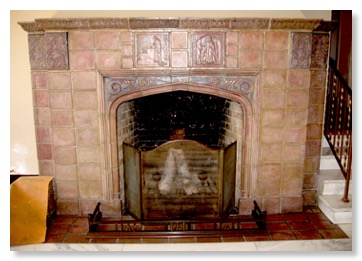
These facts would reinforce the likelihood that we may very possibly have discovered another Hamilton tile installation. Both installations were customized, one with the depiction of Artaban and the other with a heraldic shield that includes the name ‘Sovereign.’ I know most tile makers in the day offered custom designing, and the Hamilton's surely provided same. Anyway, I'm leaning in the direction that the installation is, in fact, Hamilton probably about 90%.”
Find Spring 2015 E-News in Print here.
Link to past E-News prior to 2010
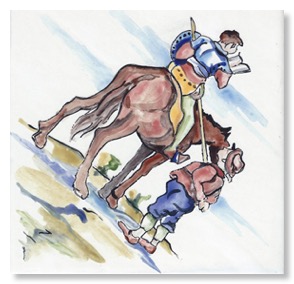
By Patricia J. Kaszas, artist
Patricia’s Tile Design, San Diego
As a custom tile painter/artist, I was commissioned by a client to replicate eight hand painted tiles out of a set of fifteen due to breakage. They were 6” x 6” and known by the owner to have been originally purchased in Madrid from Antigua Casa Talavera in the 1940s. After research, I found that this delightful Spanish tile and ceramic shop is still open and has been doing business since 1904. See: www.antiguacasatalavera.com.
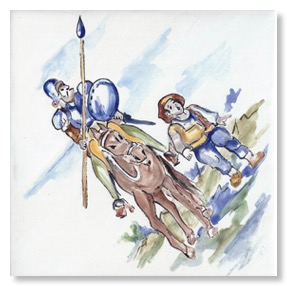
Shortly after my replication work was complete, I was curious about the art and subject of each tile and quickly learned that they all depicted various stories, excerpts and characters, from the literary novel, Don Quixote, written by Miguel Cervantes (1605), the subject of many plays, operas and art around the world over centuries. The novel is epic in content but with research, I was able, with a lot of luck, to identify the story lines that pertained to what I had painted as follows:
Tiles # 1 (above right) and #2 (left): The story setting begins in a Spanish village called La Mancha.
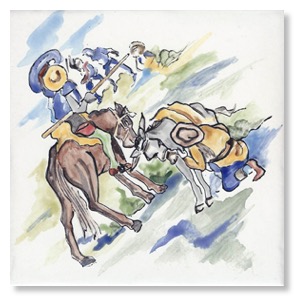
The main character, Don Quixote, is obsessed with chivalrous ideals touted in the many books he has personally read about medieval knights and bloody battles. His world becomes idealized, an imaginary fantasy living out numerous tales of delusion and deception. He decides to take up his lance and sword to defend the helpless and destroy the wicked, often while riding on his old steed named Rocinante.
Tile #3 (right): Sancho Panza is a peasant laborer whom Don Quixote takes on as his friend and squire and who rides beside him with his faithful gray donkey. During their many escapades Quixote is pictured in his knighthood attire while Sancho tries his best to correct his master’s outlandish fantasies on the roads of Spain.
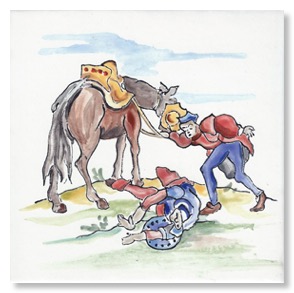
Tile #4 (left): In the Adventure of The Strolling Players, Quixote meets a traveling troupe of players dressed in costume, including one being a Jester, who tries to fool him into thinking they are all knights of sorts.
Tiles #5, #6 and #7 series (below): In An adventure with Sheep, as Quixote and Sancho ride one day, Don Quixote sees clouds of dust coming along the road and mistakes them for two great armies on the brink of battle. Sancho warns his master that the two clouds actually come from two herds of sheep. Unconvinced, Don Quixote describes in great detail the knights he thinks he sees in the dust.
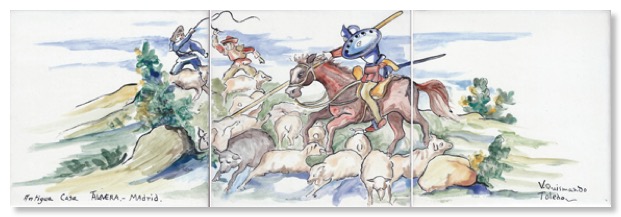
Don Quixote rushes into the battle and kills seven sheep before two shepherds throw stones at him and knock out several of his teeth. Later, Don Quixote explained that a sorcerer turned the armies into sheep in the midst of battle to thwart his efforts.
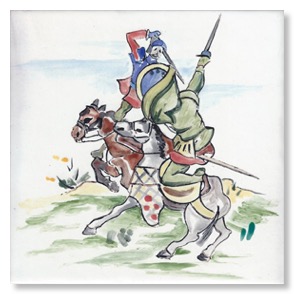
Tile # 8: (right) Don Quixote encounters The Knight of the White Moon, who challenges him and makes him swear to go home and stay there for a year if he is defeated. The two fight and The Knight of the White Moon conquers Don Quixote, forcing him to accept the condition as agreed.
TILE HERITAGE THANKS IT’S SPONSORS 
New Books
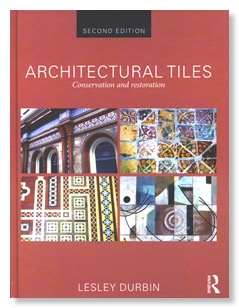
Architectural Tiles
Conservation and Restoration
By Lesley Durbin
The preservation of historic architectural tiles is central to the mission of Tile Heritage. Ms. Durbin’s recent contribution offers up-to-date information on materials, practical methods and historical research as well as the changes in attitudes and perceptions, which provide a new dimension to conservation and restoration techniques benefitting construction communities worldwide.
With over 30 years’ experience in the field, Lesley Durbin is Senior Conservator at the Jackfield Conservation Studio in England.
Available at Amazon
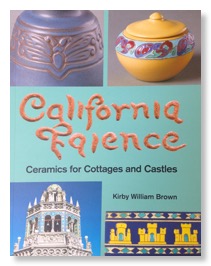
California Faience
Ceramics for Cottages and Castles
By Kirby William Brown
During the first half of the 20th century, the period we refer to as the ‘Golden Era’ in tile making on the West Coast, few companies excelled in the craft of pottery and tile making as did California Faience. The simplicity of the form coupled with the quality of the glaze came to represent the quintessence of Arts and Crafts ideals. Historian Kirby Brown tells this remarkable story from a grandson’s perspective, with his heart in every illustrative detail. To purchase, contact the author.
Joseph Taylor
Tile Heritage Foundation
Please Participate!
Join with others who already embrace their “Tile Heritage”… we have supporters who volunteer, sponsor, advocate and gift the Foundation.
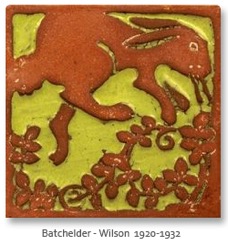
DONATIONS to THF keep the Archives Index growing by ‘Leaps and Bounds’!

THANK YOU!
* Fund the Founders Legacy in 2015
* Capitalizing the Collections for Posterity
* Help continue to build the digital Finding-Aid Index
providing online Public Access!
MAJOR DONOR INQUIRIES: We have an additional two year Archiving Fulfillment plan with budgets outlined for 2015 & 2016. (Details are available in a formal Strategic Plan document. Want the details? Email: foundation@tileheritage.org
Tiles tell tales! Your inspirations and life stories, the crafting of tiles and installations, the challenges of showroom encounters, the scholarly research in the field. Appreciate too the work and innovations of those who have come before us during centuries past! These stories are among the 40,000+ documents and 40,000+ images preserved for posterity at Tile Heritage.
MAKE A DONATION TODAY! THANK YOU!
TILE HERITAGE THANKS ITS SPONSORS 
